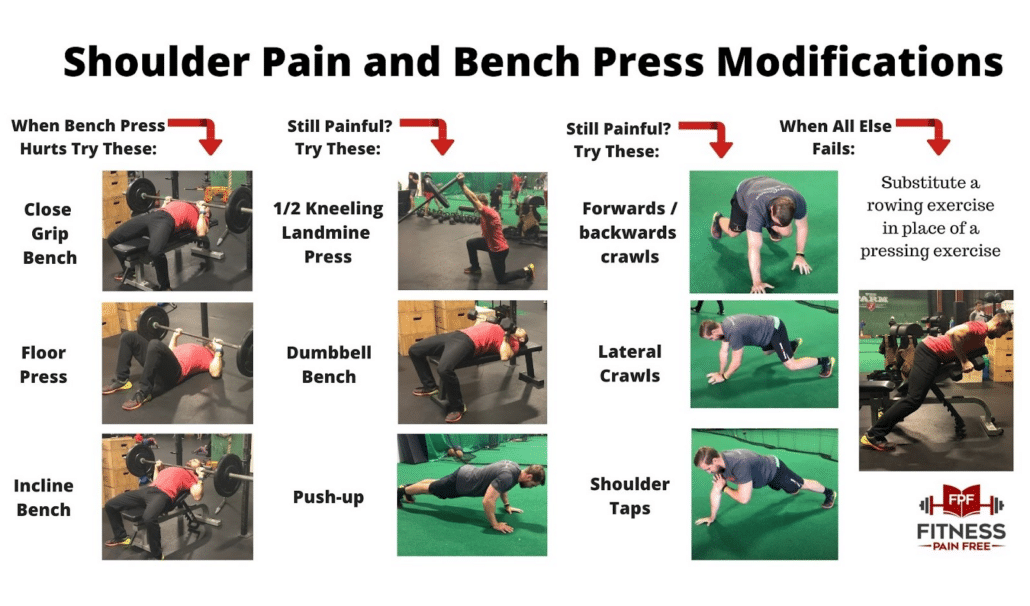If your patients are working hard in the gym, they’re going to encounter pain and injuries from time to time. This seems to be especially true regarding shoulder pain during the bench press.
With more and more people training hard in the gym, it’s important we understand how to rehabilitate injuries in these fitness athletes.
Injuries are terrible, and they can really throw a wrench into our patient’s training routine. However, it is part of the game and will happen from time to time.
With that being said, just because our patients have some pain, doesn’t mean they should stop training. Ideally, we can troubleshoot these injuries with our patients and learn how to keep training (albeit in a smarter manner) when these issues pop up. And when big injuries do pop up, how to get them back into the gym.
The bench press can be a huge source of frustration for folks with shoulder pain. It can both limit training performance and sometimes even make your bench day miserable.
If our patients keep blowing through pain during bench press, a few things can happen:
- The pain eventually goes away
- The pain stays the same
- The pain gets worse over time
I think most of us have experienced this as lifters. Sometimes you can train through pain, which gradually gets better over time. On the flip side of the coin, oftentimes the opposite happens, and we’re in more trouble than when the pain first began.
It’s a roll of the dice, really. Every time our patients play this game, they’re essentially gambling. Maybe it goes well, maybe it doesn’t. If we’re really interested in long-term performance and health for our patients we shouldn’t be gambling with their shoulder injuries.
For this reason, it’s incredibly important we learn how to modify their training so that they can continue working towards their training goals but also ensure their pain improves over the course of time. What’s great is that exercise can actually help rehabilitate the injury and simultaneously continue working towards training goals when done appropriately.
The way we do this is by learning how to dose exercise appropriately.
Think of the difference between taking two aspirin to get rid of a headache and taking the whole bottle. The whole bottle can kill you, but two aspirin works great.
The same goes for exercise. If we have an injury we must find the right dosage to help our patients heal. Imagine having a shoulder injury and bench pressing 90% of your 1 rep max for 15 sets to failure. This is kind of like taking an entire bottle of aspirin. We don’t want that. However, if we perform 3 sets of 12 dumbbell bench press with a tempo this may be the exact medicine we need to keep training and rehabilitate our patients at the same time.
So how can we find the right dosage for shoulder pain in the bench press?
The goal is to find the bench press variation and or set/rep scheme that most similarly follows the training plan for the day that is also well tolerated for the shoulder.
This generally means pain that is <5/10, feels tolerable, and pain levels return to baseline the following day. Use the guidelines below to help find the right dosage for your patients:
How to Decrease Shoulder Pain During the Bench Press
When I am working with someone that has shoulder pain during the bench press, I try to focus on modifying the exercise before immediately recommending that someone stop bench pressing.
This not only helps with the rehabilitation of the shoulder pain but also helps improve the buy-in and compliance of the patient.
I like to focus on 6 many things.
How to Decrease Shoulder Pain During the Bench Press
- Decrease total load or slow down the speed of movement – Less total load decreases stress on the shoulder.
Increase the number of reps – Increasing the number of repetitions performed in a set will decrease the total load you can lift during bench press. Think of a 5 rep max vs. a 12 rep max.
Slow down the speed of the lift or add “pauses” at the bottom of the bench press – Tempo or paused lifts will decrease the total amount of weight on the bar, potentially allowing a therapeutic dose of bench press. - Press less frequently throughout the course of the week for fewer reps – Often times decreasing total pressing volume will be enough to get out of shoulder pain.
Reduce total sets of bench press in a given session. Substitute 1-2 pressing exercises for rowing exercises within your program
- Vary the pressing exercise – Changing the angle, grip, or implement is often enough to get out of pain while pressing
Try changing to an incline or decline press.
Try changing the grip width or switching to a neutral grip bar.
Try using dumbbells. - Narrow the grip and limit the range of motion – A narrow grip and less depth will decrease stress on the AC joint
Try switching to a close grip.
Try floor press, board press, or spoto press. - Try some crawl variations as a modification – Crawl variations are usually well tolerated for painful shoulders and work similar muscle groups (pecs, delts, triceps)
Bears crawls, sideways crawls, and inchworms fit the bill here.
- Substitute pressing for rowing – If all else fails, then try substituting a pressing variation for a rowing variation.
Try a seal row, chest-supported row, single-arm dumbbell row, or any other row variation.
As you read through, you’ll see the first step to help reduce pain is to slow down the reps or slightly increase the rep range for the day. If that takes care of the issue, great. That’s all of the modification you’ll need.
If this doesn’t work out for you then you’ll need a modification. I made a handy dandy infographic below to help you figure out this process below:

You’d first try the column to the far left to see if you can find any modifications that are well tolerated. If not, you move onto the exercises in the center. If no exercises work, then finally substitute a rowing exercise in place of a pressing exercise for the day. Now you’ve got a working plan.
My general rehab advice is to initially avoid movements that are not tolerated well, and once the pain is feeling better, to slowly progress back to the movements that were initially painful.
For our example athlete above, they may have just had pain on that specific day, and the following week bench press is no longer painful, and he can return to the normal programming. If this is the case, great you’ve got your patient back in action.
However, this won’t always be the case. You may end up having to modify the bench press for several weeks (or months) and slowly work your way back up the steps until you can now bench press again without pain. Everyone is different when it comes to pain and injuries.
So there you have it, a simple plan to help your patients with shoulder pain during the bench press.
Want to Work with Fitness Athletes?
If you want to work with more fitness athletes, people that want to get out of pain and get back into the gym, then you’re going to want to check out our online course on the Rehabilitation of the Fitness Athlete.
In this comprehensive course, we’ll show you everything you need to master the basic lifts of the squat, deadlift, and press, so you can completely understand why injuries occur and how to help people avoid them in the future. Plus, it’s worth 10.75 CEUs.






